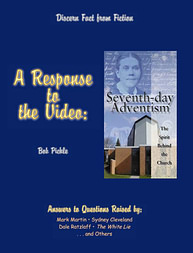| Pickle Publishing | "2nd Vision; Broken Promise" | Research Papers |
Return to https://www.pickle-publishing.com/papers/jeremiah-films/response-to-video-170.htm.
A Response to the Video:
Seventh-day Adventism, the Spirit Behind the Church
by Bob Pickle
Answers to Questions Raised by:
Mark Martin, Sydney Cleveland
Dale Ratzlaff, The White Lie
. . . and Others
Discern Fact from Fiction
The Sabbath of the Fourth Commandment
< Prev T. of C. ... 164 165-167 168-169 170-174 175-176 177-178 179-180 ... Next >
| #170, #171, #172, #173, & #174: "Why the change now nine years later? Had they not been in fact Sabbath breakers and not Sabbath keepers for the first nine years of the practice? It required another vision by Ellen White in which she promised to question the angel and get an explanation to cause the controversy to die down. 'I inquired why it had been thus, that at this late day we [p. 114] must change the time of commencing the Sabbath. Said the angel, "Ye shall understand, but not yet, not yet..." ' Spiritual Gifts vol. 4[b] p. 3-4. Mrs. White died without ever giving the promised explanation from God."—Mark Martin. |
#170: It required another vision. If it required another vision, why does Mr. Martin then proceed to quote from the same vision of November 20, 1855? Mr. Martin quotes here from pages 3 and 4. The immediately preceding page, page 2, says: "November 20, 1855, while in prayer, the Spirit of the Lord suddenly and powerfully came upon me, and I was taken off in vision." That makes this vision the same as the one referred to by the narrator under #165-#167, meaning that there was no other vision.
#171: She promised in her vision to question the angel and get an explanation. Will the reader please notice what Mr. Martin quoted? She made no such promise in the vision. Rather, the angel promised that an explanation would come later.
#172: The angel said, "Not yet, not yet." Let's quote just a little more of this very passage. The second sentence after where Mr. Martin stopped says: "I saw that it was in the minds of some that the Lord had shown that the Sabbath commenced at six o'clock, when I had only seen that it commenced at 'even,' and it was inferred that even was at six."
If Mr. Martin had only read two more sentences, his questions would have been totally answered.
This quotation from Spiritual Gifts appears under "Point 85" in the documentation package. The last five lines of the paragraph are strangely missing. The last words before the cut-off lines are, "I saw that it was in the," the first seven words from the above sentence.
You might think this is evidence of dishonesty, and it does look quite incriminating. It appears that the compiler was trying to hide the truth from the reader. But actually, it could be just simple human error.
The documentation package provides 77 different extracts from the CD-ROM of Mrs. White's writings, 55 of which contain material that she really wrote. The compiler was using the Windows version of the software which provides two ways of printing out a desired selection. One can either print out the whole paragraph, or the current window being viewed, a default of 27 lines.
16 extracts went beyond a single window, and were included in their entirety in the documentation package. 4 others, including the one under discussion, were cut off at the end of the first window, omitting between 2 and 7 lines of material. Of these 4, only this one's missing lines represent context vital to the discussion.
So it is possible that the compiler neglected to read the last five lines and had the "window" "print range" setting checked. Yet even if this was a simple oversight, it really is inexcusable. Whenever one attacks something as sacred as someone's religious faith, it is wise to be certain of the facts first. And when ascertaining facts means reading only two more sentences or five more lines, finishing the paragraph becomes a Christian duty.
#173: She died without ever giving the promised explanation. The careful reader will note that the angel never said who would give the promised explanation. Mr. Martin thinks it had to be Mrs. White, but that's not what the passage said.
#174: The promised explanation was never given. Actually, the promised explanation appeared in Smith's book which the narrator quoted from (see #167):
"2. Elder J.B., who was the first to teach the Sabbath in its importance, and faithfully labor to bring out a people from among the Adventists to observe it, was very decided upon the question, and respect for his years, and his godly life, might have been among the reasons why this point was not sooner investigated as thoroughly as some other points."—p. 89.
Seventh-day Adventists had relied on someone's opinion instead of searching out what the Bible actually taught on the matter. For this reason, they had to make a change after not quite keeping the Sabbath correctly for nine years.
This explanation was given publicly in the Review and Herald in 1868 (vol. 31 no. 11), and then reprinted in Smith's book of that year. This was a total of 47 years before Mrs. White's death.
|
< Prev T. of C. ... 164 165-167 168-169 170-174 175-176 177-178 179-180 ... Next >
© 2005
Pickle Publishing
